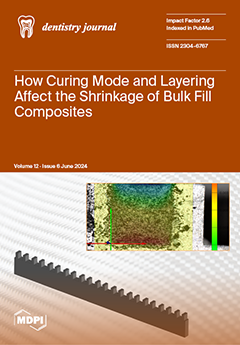Background: Amelogenesis imperfecta is a hereditary disorder affecting dental enamel. Among its phenotypes, hypocalcified AI is characterized by mineral deficiency, leading to tissue wear and, consequently, dental sensitivity. Excessive fluoride intake (through drinking water, fluoride supplements, toothpaste, or by ingesting products such as
[...] Read more.
Background: Amelogenesis imperfecta is a hereditary disorder affecting dental enamel. Among its phenotypes, hypocalcified AI is characterized by mineral deficiency, leading to tissue wear and, consequently, dental sensitivity. Excessive fluoride intake (through drinking water, fluoride supplements, toothpaste, or by ingesting products such as pesticides or insecticides) can lead to a condition known as dental fluorosis, which manifests as stains and teeth discoloration affecting their structure. Our recent studies have shown that extracts from Colombian native plants,
Ilex guayusa and
Piper marginatum, deposit mineral ions such as phosphate and orthophosphate into the dental enamel structure; however, it is unknown whether these extracts produce toxic effects on the dental pulp. Objective: To assess cytotoxicity effects on human dental pulp stem cells (hDPSCs) exposed to extracts isolated from
I. guayusa and
P.
marginatum and, hence, their safety for clinical use. Methods: Raman spectroscopy, fluorescence microscopy, and flow cytometry techniques were employed. For Raman spectroscopy, hDPSCs were seeded onto nanobiochips designed to provide surface-enhanced Raman spectroscopy (SERS effect), which enhances their Raman signal by several orders of magnitude. After eight days in culture,
I. guayusa and
P. marginatum extracts at different concentrations (10, 50, and 100 ppm) were added. Raman measurements were performed at 0, 12, and 24 h following extract application. Fluorescence microscopy was conducted using an OLIMPUS fv1000 microscope, a live–dead assay was performed using a kit employing a BD FACS Canto TM II flow cytometer, and data analysis was determined using a FlowJo program. Results: The Raman spectroscopy results showed spectra consistent with viable cells. These findings were corroborated using fluorescence microscopy and flow cytometry techniques, confirming high cellular viability. Conclusions: The analyzed extracts exhibited low cytotoxicity, suggesting that they could be safely applied on enamel for remineralization purposes. The use of nanobiochips for SERS effect improved the cell viability assessment.
Full article






